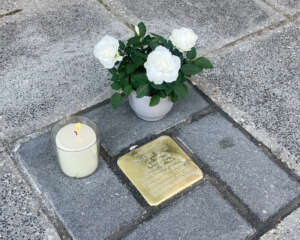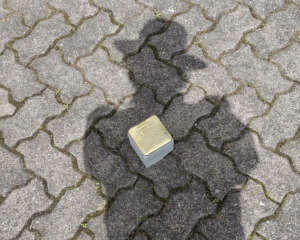Opinions
The 100,000th Stone


Gunter Demnig, the conceptual artist, initially envisioned the Stolpersteine project (meaning “stumbling stones”) to commemorate Roma, Sinti, and disabled victims of National Socialism in his home country of Germany. Little did he know that his project would become the world’s largest decentralized memorial. The Netherlands, with the second-highest percentage of Jews murdered by the Nazis after Poland, has seen a significant demand for stolpersteine since Demnig laid the first ones there in 2007. In fact, the demand for these commemorative stones is greater in the Netherlands than anywhere else.
Our upcoming documentary, HERE LIVED, primarily focuses on the Dutch Stolpersteine project. However, we recently traveled to Nuremberg, Germany, to witness Gunter Demnig laying the 100,000th Stolpersteine on May 26th. This event was a perfect conclusion to HERE LIVED, and we were honored to film it.
Although 100,000 may appear to be a large figure, it pales in comparison to the actual number of lives lost – 12 million – as a result of the Nazi regime during WWII. Gunter Demnig created Stolpersteine to commemorate each individual by their name, life, and contributions, rather than reducing them to mere statistics. Among the nine stones placed that day in honor of Nazi victims, Johann Wild’s is the 100,000th.
Johann Wild was born on May 24, 1892, in Nuremberg. He received training as a mechanic and worked for the fire department in Nürnberger after the First World War. He resided with his wife Emma and daughter Elvira at Bartholomäusstrasse 29a, where the commemorative stone was placed. Until 1933, he was affiliated with the SPD, the Reichsbanner, and the Iron Front. During World War II, he listened to foreign radio stations and was politically motivated to send several letters to das Reich Ministry of Propaganda in 1939 and 1940 under a pseudonym. In these letters, he criticized Hitler, the Nazi state, and exposed their crimes. However, the police discovered documents that proved his authorship of these letters, leading to his sentencing to death by the Nuremberg Special Court on March 7, 1941. He was arrested on May 17, 1941, and executed by guillotine in Munich-Stadelheim prison.
Capturing the placement of the 100,000th Stolpersteine serves as a crucial reminder that each stone represents a human life lost. Now more than ever, it’s critically important to record and remember these crimes against humanity. Filming is now complete and our team is working tirelessly in the editing room to create a powerful and impactful narrative. To stay informed about HERE LIVED and our efforts to amplify voices, please visit our website, sign up for our monthly newsletter, and connect with us on social media @3_generations.


The laying of the 100,000th stone was highly documented, garnering press coverage from around the world. You can view a few of the publications here: ‘Stolpersteine’: Commemorating victims of Nazi persecution The 100,000th stumbling stone will be laid in Nuremberg on Thursday ‘Stolpersteine’: Commemorating victims of Nazi persecution – Taiwan News ‘Stolpersteine’: Commemorating victims of Nazi persecution – Lumi News




